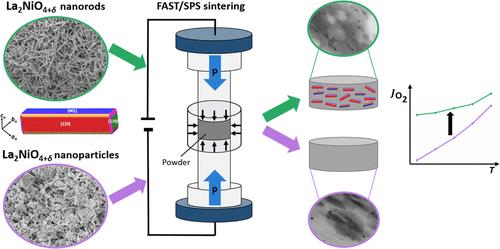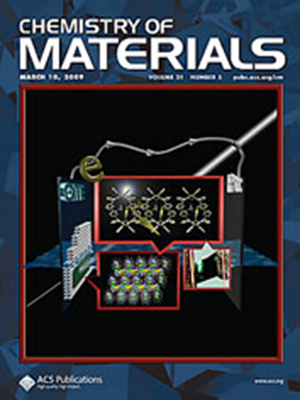Giamper Escobar Cano, Merle Wellmann, Frank Steinbach, Moritz Thiem, Wenjie Xie, Anke Weidenkaff, Armin Feldhoff
求助PDF
{"title":"通过微乳液法合成,利用晶体面工程提高 La2NiO4+δ 氧传输膜的性能","authors":"Giamper Escobar Cano, Merle Wellmann, Frank Steinbach, Moritz Thiem, Wenjie Xie, Anke Weidenkaff, Armin Feldhoff","doi":"10.1021/acs.chemmater.4c01570","DOIUrl":null,"url":null,"abstract":"La<sub>2</sub>NiO<sub>4+δ</sub> nanorods, synthesized via reverse microemulsion─a crystal facet engineering method─served as building blocks for developing oxygen transport membranes. Comparisons were drawn with ceramic membranes derived from commercial La<sub>2</sub>NiO<sub>4+δ</sub> nanoparticles. The membrane manufacturing process involved either conventional sintering or the field-assisted sintering technique/spark plasma sintering. The microstructure analysis of the initial powders and the resulting ceramics was thoroughly assessed by X-ray diffraction, scanning and transmission electron microscopy as well as energy-dispersive X-ray spectroscopy. As a consequence of the reaction conditions, the nanorods possess an orthorhombic crystal structure, with LaOBr present as a minor phase. Furthermore, the surface structure of the La<sub>2</sub>NiO<sub>4+δ</sub> nanorods was discerned via selected area electron diffraction, revealing a composition of (001)<sub>o</sub>-type and (1<i></i><span style=\"color: inherit;\"></span><span data-mathml='<math xmlns=\"http://www.w3.org/1998/Math/MathML\" display=\"inline\"><mover><mi mathvariant=\"normal\">1</mi><mo accent=\"true\" stretchy=\"false\">&#xAF;</mo></mover></math>' role=\"presentation\" style=\"position: relative;\" tabindex=\"0\"><nobr aria-hidden=\"true\"><span style=\"width: 0.571em; display: inline-block;\"><span style=\"display: inline-block; position: relative; width: 0.514em; height: 0px; font-size: 110%;\"><span style=\"position: absolute; clip: rect(1.139em, 1000.4em, 2.332em, -999.997em); top: -2.156em; left: 0em;\"><span><span><span style=\"display: inline-block; position: relative; width: 0.514em; height: 0px;\"><span style=\"position: absolute; clip: rect(3.128em, 1000.4em, 4.151em, -999.997em); top: -3.974em; left: 0em;\"><span style=\"font-family: STIXMathJax_Main;\">1</span><span style=\"display: inline-block; width: 0px; height: 3.98em;\"></span></span><span style=\"position: absolute; clip: rect(3.185em, 1000.34em, 3.582em, -999.997em); top: -4.259em; left: 0.06em;\"><span style=\"font-family: STIXMathJax_Main;\">¯</span><span style=\"display: inline-block; width: 0px; height: 3.98em;\"></span></span></span></span></span><span style=\"display: inline-block; width: 0px; height: 2.162em;\"></span></span></span><span style=\"display: inline-block; overflow: hidden; vertical-align: -0.059em; border-left: 0px solid; width: 0px; height: 1.066em;\"></span></span></nobr><span role=\"presentation\"><math display=\"inline\" xmlns=\"http://www.w3.org/1998/Math/MathML\"><mover><mi mathvariant=\"normal\">1</mi><mo accent=\"true\" stretchy=\"false\">¯</mo></mover></math></span></span><script type=\"math/mml\"><math display=\"inline\"><mover><mi mathvariant=\"normal\">1</mi><mo accent=\"true\" stretchy=\"false\">¯</mo></mover></math></script>0)<sub>o</sub>-type facets on the sides and (110)<sub>o</sub>-type facets at the end, with additional facets observed between these surfaces. Among the sintering techniques, spark plasma sintering demonstrated superior performance, when applied to La<sub>2</sub>NiO<sub>4+δ</sub> nanorods, as it effectively preserved their rod-like nanostructure during the sintering process. The resulting nanorod-derived La<sub>2</sub>NiO<sub>4+δ</sub> ceramics exhibited excellent oxygen permeation, largely due to the large proportion of orthorhombic (1<i></i><span style=\"color: inherit;\"></span><span data-mathml='<math xmlns=\"http://www.w3.org/1998/Math/MathML\" display=\"inline\"><mover><mi mathvariant=\"normal\">1</mi><mo accent=\"true\" stretchy=\"false\">&#xAF;</mo></mover></math>' role=\"presentation\" style=\"position: relative;\" tabindex=\"0\"><nobr aria-hidden=\"true\"><span style=\"width: 0.571em; display: inline-block;\"><span style=\"display: inline-block; position: relative; width: 0.514em; height: 0px; font-size: 110%;\"><span style=\"position: absolute; clip: rect(1.139em, 1000.4em, 2.332em, -999.997em); top: -2.156em; left: 0em;\"><span><span><span style=\"display: inline-block; position: relative; width: 0.514em; height: 0px;\"><span style=\"position: absolute; clip: rect(3.128em, 1000.4em, 4.151em, -999.997em); top: -3.974em; left: 0em;\"><span style=\"font-family: STIXMathJax_Main;\">1</span><span style=\"display: inline-block; width: 0px; height: 3.98em;\"></span></span><span style=\"position: absolute; clip: rect(3.185em, 1000.34em, 3.582em, -999.997em); top: -4.259em; left: 0.06em;\"><span style=\"font-family: STIXMathJax_Main;\">¯</span><span style=\"display: inline-block; width: 0px; height: 3.98em;\"></span></span></span></span></span><span style=\"display: inline-block; width: 0px; height: 2.162em;\"></span></span></span><span style=\"display: inline-block; overflow: hidden; vertical-align: -0.059em; border-left: 0px solid; width: 0px; height: 1.066em;\"></span></span></nobr><span role=\"presentation\"><math display=\"inline\" xmlns=\"http://www.w3.org/1998/Math/MathML\"><mover><mi mathvariant=\"normal\">1</mi><mo accent=\"true\" stretchy=\"false\">¯</mo></mover></math></span></span><script type=\"math/mml\"><math display=\"inline\"><mover><mi mathvariant=\"normal\">1</mi><mo accent=\"true\" stretchy=\"false\">¯</mo></mover></math></script>0)<sub>o</sub>-type surfaces in the rod-shaped grains, which correspond to tetragonal (010)<sub>t</sub> and (0<i></i><span style=\"color: inherit;\"></span><span data-mathml='<math xmlns=\"http://www.w3.org/1998/Math/MathML\" display=\"inline\"><mover><mi mathvariant=\"normal\">1</mi><mo accent=\"true\" stretchy=\"false\">&#xAF;</mo></mover></math>' role=\"presentation\" style=\"position: relative;\" tabindex=\"0\"><nobr aria-hidden=\"true\"><span style=\"width: 0.571em; display: inline-block;\"><span style=\"display: inline-block; position: relative; width: 0.514em; height: 0px; font-size: 110%;\"><span style=\"position: absolute; clip: rect(1.139em, 1000.4em, 2.332em, -999.997em); top: -2.156em; left: 0em;\"><span><span><span style=\"display: inline-block; position: relative; width: 0.514em; height: 0px;\"><span style=\"position: absolute; clip: rect(3.128em, 1000.4em, 4.151em, -999.997em); top: -3.974em; left: 0em;\"><span style=\"font-family: STIXMathJax_Main;\">1</span><span style=\"display: inline-block; width: 0px; height: 3.98em;\"></span></span><span style=\"position: absolute; clip: rect(3.185em, 1000.34em, 3.582em, -999.997em); top: -4.259em; left: 0.06em;\"><span style=\"font-family: STIXMathJax_Main;\">¯</span><span style=\"display: inline-block; width: 0px; height: 3.98em;\"></span></span></span></span></span><span style=\"display: inline-block; width: 0px; height: 2.162em;\"></span></span></span><span style=\"display: inline-block; overflow: hidden; vertical-align: -0.059em; border-left: 0px solid; width: 0px; height: 1.066em;\"></span></span></nobr><span role=\"presentation\"><math display=\"inline\" xmlns=\"http://www.w3.org/1998/Math/MathML\"><mover><mi mathvariant=\"normal\">1</mi><mo accent=\"true\" stretchy=\"false\">¯</mo></mover></math></span></span><script type=\"math/mml\"><math display=\"inline\"><mover><mi mathvariant=\"normal\">1</mi><mo accent=\"true\" stretchy=\"false\">¯</mo></mover></math></script>0)<sub>t</sub> surfaces. The (1<i></i><span style=\"color: inherit;\"></span><span data-mathml='<math xmlns=\"http://www.w3.org/1998/Math/MathML\" display=\"inline\"><mover><mi mathvariant=\"normal\">1</mi><mo accent=\"true\" stretchy=\"false\">&#xAF;</mo></mover></math>' role=\"presentation\" style=\"position: relative;\" tabindex=\"0\"><nobr aria-hidden=\"true\"><span style=\"width: 0.571em; display: inline-block;\"><span style=\"display: inline-block; position: relative; width: 0.514em; height: 0px; font-size: 110%;\"><span style=\"position: absolute; clip: rect(1.139em, 1000.4em, 2.332em, -999.997em); top: -2.156em; left: 0em;\"><span><span><span style=\"display: inline-block; position: relative; width: 0.514em; height: 0px;\"><span style=\"position: absolute; clip: rect(3.128em, 1000.4em, 4.151em, -999.997em); top: -3.974em; left: 0em;\"><span style=\"font-family: STIXMathJax_Main;\">1</span><span style=\"display: inline-block; width: 0px; height: 3.98em;\"></span></span><span style=\"position: absolute; clip: rect(3.185em, 1000.34em, 3.582em, -999.997em); top: -4.259em; left: 0.06em;\"><span style=\"font-family: STIXMathJax_Main;\">¯</span><span style=\"display: inline-block; width: 0px; height: 3.98em;\"></span></span></span></span></span><span style=\"display: inline-block; width: 0px; height: 2.162em;\"></span></span></span><span style=\"display: inline-block; overflow: hidden; vertical-align: -0.059em; border-left: 0px solid; width: 0px; height: 1.066em;\"></span></span></nobr><span role=\"presentation\"><math display=\"inline\" xmlns=\"http://www.w3.org/1998/Math/MathML\"><mover><mi mathvariant=\"normal\">1</mi><mo accent=\"true\" stretchy=\"false\">¯</mo></mover></math></span></span><script type=\"math/mml\"><math display=\"inline\"><mover><mi mathvariant=\"normal\">1</mi><mo accent=\"true\" stretchy=\"false\">¯</mo></mover></math></script>0)<sub>o</sub>-type facets facilitated the oxygen surface exchange, leading to improved oxygen permeation fluxes between 1023 and 1123 K compared to membranes derived from nanoparticles.","PeriodicalId":33,"journal":{"name":"Chemistry of Materials","volume":"31 1","pages":""},"PeriodicalIF":7.2000,"publicationDate":"2024-09-24","publicationTypes":"Journal Article","fieldsOfStudy":null,"isOpenAccess":false,"openAccessPdf":"","citationCount":"0","resultStr":"{\"title\":\"Enhanced Performance of La2NiO4+δ Oxygen-Transporting Membranes Using Crystal Facet Engineering via Microemulsion-Based Synthesis\",\"authors\":\"Giamper Escobar Cano, Merle Wellmann, Frank Steinbach, Moritz Thiem, Wenjie Xie, Anke Weidenkaff, Armin Feldhoff\",\"doi\":\"10.1021/acs.chemmater.4c01570\",\"DOIUrl\":null,\"url\":null,\"abstract\":\"La<sub>2</sub>NiO<sub>4+δ</sub> nanorods, synthesized via reverse microemulsion─a crystal facet engineering method─served as building blocks for developing oxygen transport membranes. Comparisons were drawn with ceramic membranes derived from commercial La<sub>2</sub>NiO<sub>4+δ</sub> nanoparticles. The membrane manufacturing process involved either conventional sintering or the field-assisted sintering technique/spark plasma sintering. The microstructure analysis of the initial powders and the resulting ceramics was thoroughly assessed by X-ray diffraction, scanning and transmission electron microscopy as well as energy-dispersive X-ray spectroscopy. As a consequence of the reaction conditions, the nanorods possess an orthorhombic crystal structure, with LaOBr present as a minor phase. Furthermore, the surface structure of the La<sub>2</sub>NiO<sub>4+δ</sub> nanorods was discerned via selected area electron diffraction, revealing a composition of (001)<sub>o</sub>-type and (1<i></i><span style=\\\"color: inherit;\\\"></span><span data-mathml='<math xmlns=\\\"http://www.w3.org/1998/Math/MathML\\\" display=\\\"inline\\\"><mover><mi mathvariant=\\\"normal\\\">1</mi><mo accent=\\\"true\\\" stretchy=\\\"false\\\">&#xAF;</mo></mover></math>' role=\\\"presentation\\\" style=\\\"position: relative;\\\" tabindex=\\\"0\\\"><nobr aria-hidden=\\\"true\\\"><span style=\\\"width: 0.571em; display: inline-block;\\\"><span style=\\\"display: inline-block; position: relative; width: 0.514em; height: 0px; font-size: 110%;\\\"><span style=\\\"position: absolute; clip: rect(1.139em, 1000.4em, 2.332em, -999.997em); top: -2.156em; left: 0em;\\\"><span><span><span style=\\\"display: inline-block; position: relative; width: 0.514em; height: 0px;\\\"><span style=\\\"position: absolute; clip: rect(3.128em, 1000.4em, 4.151em, -999.997em); top: -3.974em; left: 0em;\\\"><span style=\\\"font-family: STIXMathJax_Main;\\\">1</span><span style=\\\"display: inline-block; width: 0px; height: 3.98em;\\\"></span></span><span style=\\\"position: absolute; clip: rect(3.185em, 1000.34em, 3.582em, -999.997em); top: -4.259em; left: 0.06em;\\\"><span style=\\\"font-family: STIXMathJax_Main;\\\">¯</span><span style=\\\"display: inline-block; width: 0px; height: 3.98em;\\\"></span></span></span></span></span><span style=\\\"display: inline-block; width: 0px; height: 2.162em;\\\"></span></span></span><span style=\\\"display: inline-block; overflow: hidden; vertical-align: -0.059em; border-left: 0px solid; width: 0px; height: 1.066em;\\\"></span></span></nobr><span role=\\\"presentation\\\"><math display=\\\"inline\\\" xmlns=\\\"http://www.w3.org/1998/Math/MathML\\\"><mover><mi mathvariant=\\\"normal\\\">1</mi><mo accent=\\\"true\\\" stretchy=\\\"false\\\">¯</mo></mover></math></span></span><script type=\\\"math/mml\\\"><math display=\\\"inline\\\"><mover><mi mathvariant=\\\"normal\\\">1</mi><mo accent=\\\"true\\\" stretchy=\\\"false\\\">¯</mo></mover></math></script>0)<sub>o</sub>-type facets on the sides and (110)<sub>o</sub>-type facets at the end, with additional facets observed between these surfaces. Among the sintering techniques, spark plasma sintering demonstrated superior performance, when applied to La<sub>2</sub>NiO<sub>4+δ</sub> nanorods, as it effectively preserved their rod-like nanostructure during the sintering process. The resulting nanorod-derived La<sub>2</sub>NiO<sub>4+δ</sub> ceramics exhibited excellent oxygen permeation, largely due to the large proportion of orthorhombic (1<i></i><span style=\\\"color: inherit;\\\"></span><span data-mathml='<math xmlns=\\\"http://www.w3.org/1998/Math/MathML\\\" display=\\\"inline\\\"><mover><mi mathvariant=\\\"normal\\\">1</mi><mo accent=\\\"true\\\" stretchy=\\\"false\\\">&#xAF;</mo></mover></math>' role=\\\"presentation\\\" style=\\\"position: relative;\\\" tabindex=\\\"0\\\"><nobr aria-hidden=\\\"true\\\"><span style=\\\"width: 0.571em; display: inline-block;\\\"><span style=\\\"display: inline-block; position: relative; width: 0.514em; height: 0px; font-size: 110%;\\\"><span style=\\\"position: absolute; clip: rect(1.139em, 1000.4em, 2.332em, -999.997em); top: -2.156em; left: 0em;\\\"><span><span><span style=\\\"display: inline-block; position: relative; width: 0.514em; height: 0px;\\\"><span style=\\\"position: absolute; clip: rect(3.128em, 1000.4em, 4.151em, -999.997em); top: -3.974em; left: 0em;\\\"><span style=\\\"font-family: STIXMathJax_Main;\\\">1</span><span style=\\\"display: inline-block; width: 0px; height: 3.98em;\\\"></span></span><span style=\\\"position: absolute; clip: rect(3.185em, 1000.34em, 3.582em, -999.997em); top: -4.259em; left: 0.06em;\\\"><span style=\\\"font-family: STIXMathJax_Main;\\\">¯</span><span style=\\\"display: inline-block; width: 0px; height: 3.98em;\\\"></span></span></span></span></span><span style=\\\"display: inline-block; width: 0px; height: 2.162em;\\\"></span></span></span><span style=\\\"display: inline-block; overflow: hidden; vertical-align: -0.059em; border-left: 0px solid; width: 0px; height: 1.066em;\\\"></span></span></nobr><span role=\\\"presentation\\\"><math display=\\\"inline\\\" xmlns=\\\"http://www.w3.org/1998/Math/MathML\\\"><mover><mi mathvariant=\\\"normal\\\">1</mi><mo accent=\\\"true\\\" stretchy=\\\"false\\\">¯</mo></mover></math></span></span><script type=\\\"math/mml\\\"><math display=\\\"inline\\\"><mover><mi mathvariant=\\\"normal\\\">1</mi><mo accent=\\\"true\\\" stretchy=\\\"false\\\">¯</mo></mover></math></script>0)<sub>o</sub>-type surfaces in the rod-shaped grains, which correspond to tetragonal (010)<sub>t</sub> and (0<i></i><span style=\\\"color: inherit;\\\"></span><span data-mathml='<math xmlns=\\\"http://www.w3.org/1998/Math/MathML\\\" display=\\\"inline\\\"><mover><mi mathvariant=\\\"normal\\\">1</mi><mo accent=\\\"true\\\" stretchy=\\\"false\\\">&#xAF;</mo></mover></math>' role=\\\"presentation\\\" style=\\\"position: relative;\\\" tabindex=\\\"0\\\"><nobr aria-hidden=\\\"true\\\"><span style=\\\"width: 0.571em; display: inline-block;\\\"><span style=\\\"display: inline-block; position: relative; width: 0.514em; height: 0px; font-size: 110%;\\\"><span style=\\\"position: absolute; clip: rect(1.139em, 1000.4em, 2.332em, -999.997em); top: -2.156em; left: 0em;\\\"><span><span><span style=\\\"display: inline-block; position: relative; width: 0.514em; height: 0px;\\\"><span style=\\\"position: absolute; clip: rect(3.128em, 1000.4em, 4.151em, -999.997em); top: -3.974em; left: 0em;\\\"><span style=\\\"font-family: STIXMathJax_Main;\\\">1</span><span style=\\\"display: inline-block; width: 0px; height: 3.98em;\\\"></span></span><span style=\\\"position: absolute; clip: rect(3.185em, 1000.34em, 3.582em, -999.997em); top: -4.259em; left: 0.06em;\\\"><span style=\\\"font-family: STIXMathJax_Main;\\\">¯</span><span style=\\\"display: inline-block; width: 0px; height: 3.98em;\\\"></span></span></span></span></span><span style=\\\"display: inline-block; width: 0px; height: 2.162em;\\\"></span></span></span><span style=\\\"display: inline-block; overflow: hidden; vertical-align: -0.059em; border-left: 0px solid; width: 0px; height: 1.066em;\\\"></span></span></nobr><span role=\\\"presentation\\\"><math display=\\\"inline\\\" xmlns=\\\"http://www.w3.org/1998/Math/MathML\\\"><mover><mi mathvariant=\\\"normal\\\">1</mi><mo accent=\\\"true\\\" stretchy=\\\"false\\\">¯</mo></mover></math></span></span><script type=\\\"math/mml\\\"><math display=\\\"inline\\\"><mover><mi mathvariant=\\\"normal\\\">1</mi><mo accent=\\\"true\\\" stretchy=\\\"false\\\">¯</mo></mover></math></script>0)<sub>t</sub> surfaces. The (1<i></i><span style=\\\"color: inherit;\\\"></span><span data-mathml='<math xmlns=\\\"http://www.w3.org/1998/Math/MathML\\\" display=\\\"inline\\\"><mover><mi mathvariant=\\\"normal\\\">1</mi><mo accent=\\\"true\\\" stretchy=\\\"false\\\">&#xAF;</mo></mover></math>' role=\\\"presentation\\\" style=\\\"position: relative;\\\" tabindex=\\\"0\\\"><nobr aria-hidden=\\\"true\\\"><span style=\\\"width: 0.571em; display: inline-block;\\\"><span style=\\\"display: inline-block; position: relative; width: 0.514em; height: 0px; font-size: 110%;\\\"><span style=\\\"position: absolute; clip: rect(1.139em, 1000.4em, 2.332em, -999.997em); top: -2.156em; left: 0em;\\\"><span><span><span style=\\\"display: inline-block; position: relative; width: 0.514em; height: 0px;\\\"><span style=\\\"position: absolute; clip: rect(3.128em, 1000.4em, 4.151em, -999.997em); top: -3.974em; left: 0em;\\\"><span style=\\\"font-family: STIXMathJax_Main;\\\">1</span><span style=\\\"display: inline-block; width: 0px; height: 3.98em;\\\"></span></span><span style=\\\"position: absolute; clip: rect(3.185em, 1000.34em, 3.582em, -999.997em); top: -4.259em; left: 0.06em;\\\"><span style=\\\"font-family: STIXMathJax_Main;\\\">¯</span><span style=\\\"display: inline-block; width: 0px; height: 3.98em;\\\"></span></span></span></span></span><span style=\\\"display: inline-block; width: 0px; height: 2.162em;\\\"></span></span></span><span style=\\\"display: inline-block; overflow: hidden; vertical-align: -0.059em; border-left: 0px solid; width: 0px; height: 1.066em;\\\"></span></span></nobr><span role=\\\"presentation\\\"><math display=\\\"inline\\\" xmlns=\\\"http://www.w3.org/1998/Math/MathML\\\"><mover><mi mathvariant=\\\"normal\\\">1</mi><mo accent=\\\"true\\\" stretchy=\\\"false\\\">¯</mo></mover></math></span></span><script type=\\\"math/mml\\\"><math display=\\\"inline\\\"><mover><mi mathvariant=\\\"normal\\\">1</mi><mo accent=\\\"true\\\" stretchy=\\\"false\\\">¯</mo></mover></math></script>0)<sub>o</sub>-type facets facilitated the oxygen surface exchange, leading to improved oxygen permeation fluxes between 1023 and 1123 K compared to membranes derived from nanoparticles.\",\"PeriodicalId\":33,\"journal\":{\"name\":\"Chemistry of Materials\",\"volume\":\"31 1\",\"pages\":\"\"},\"PeriodicalIF\":7.2000,\"publicationDate\":\"2024-09-24\",\"publicationTypes\":\"Journal Article\",\"fieldsOfStudy\":null,\"isOpenAccess\":false,\"openAccessPdf\":\"\",\"citationCount\":\"0\",\"resultStr\":null,\"platform\":\"Semanticscholar\",\"paperid\":null,\"PeriodicalName\":\"Chemistry of Materials\",\"FirstCategoryId\":\"88\",\"ListUrlMain\":\"https://doi.org/10.1021/acs.chemmater.4c01570\",\"RegionNum\":2,\"RegionCategory\":\"材料科学\",\"ArticlePicture\":[],\"TitleCN\":null,\"AbstractTextCN\":null,\"PMCID\":null,\"EPubDate\":\"\",\"PubModel\":\"\",\"JCR\":\"Q2\",\"JCRName\":\"CHEMISTRY, PHYSICAL\",\"Score\":null,\"Total\":0}","platform":"Semanticscholar","paperid":null,"PeriodicalName":"Chemistry of Materials","FirstCategoryId":"88","ListUrlMain":"https://doi.org/10.1021/acs.chemmater.4c01570","RegionNum":2,"RegionCategory":"材料科学","ArticlePicture":[],"TitleCN":null,"AbstractTextCN":null,"PMCID":null,"EPubDate":"","PubModel":"","JCR":"Q2","JCRName":"CHEMISTRY, PHYSICAL","Score":null,"Total":0}
引用次数: 0
引用
批量引用


 求助内容:
求助内容: 应助结果提醒方式:
应助结果提醒方式:


